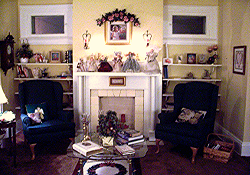Greetings sweet friends!!! I am finally taking a minute to sit down at my faithful old computer and write a little bit on my blog today. I have been a busy momma this morning with a swirl of activity including working with Caleb on his lessons, helping my sweet hubby set up our little Winter Village on the living room shelves and working on getting our house ready for our family's Thanksgiving Day dinner!!! I can't wait to have everyone gathered in and enjoying a wonderful meal together! I didn't want to forget my Design History post today and hope that you are enjoying my little series. Today's slice of history includes a little bit of church history, as well. Grab a cup of tea and join me in a little travel back in time:
Early Church and Byzantine Period: A.D. 330-1453
During the time in history known as the Middle Ages, A.D. 330-1453, the focus in Rome turned from the civic order of the Roman Empire to an emphasis on spiritual awareness found in the newly recognized Christian church Before this time Christian followers had met in secret within the deep catacombs beneath the streets of Rome or in the modest homes of fellow believers. Since most of the parishioners of these secret congregations had no guiding example for the design of church structures, the challenge came with the question, “what should a church look like”?
The immediate answer was to look toward the temple buildings of ancient Greece and earlier Rome. The columns that once honored the gods of Greece and earlier Roman emperors would be resurrected to honor Christ the resurrected Son of God. Over time the descendants of the aristocratic families of the Roman Empire began to adopt the new faith and came to the church for protection from attacking barbarians that had spread through the empire. They were willing to give their wealth to the church in exchange for their assistance. The building of the old Church of St. Peter established the beginning of the Early Christian period in Rome. The building exhibited a style that was based on the Roman basilica and had a narthex area toward the front with five parallel aisles that opened onto a formal atrium area. The widest center aisle, or nave, featured a curved apse area at its end. Other building styles that were used for early ecclesiastical structures included the central plan that included round and polygon forms. These buildings styles were often used for mausoleums and baptisteries. Mausoleums held the large stone sarcophagus under the central dome built on columns.
During this period the principals of the Vitruvian School gave way to new passions in the interest of relating the gospel through art and architecture. The façade of early churches maintained a form that was minimal in ornamentation while the interiors boasted beautiful frescos and carved moldings developed by the Greek, Egyptian and Celtic cultures. Coptic designs from Egypt were seen in illuminated manuscripts, glass, ivory and sculpture. Intertwining designs of knot work from Celtic lands became a popular motif for church interiors combined with rinceau carvings. Mosaics that portrayed Christian saints and martyrs could be seen on walls of nave corridors.
The military appeal and grand scenery of the ancient city of Byzantium drew Constantine to relocate the capital of the Roman Empire to its location toward the end of his reign. He renamed his new capital Constantinople as this was the custom of the day. The styles of architecture and decorative techniques of this near Asian city became a large part of the new structures built by the Roman government. This is the period that is known as the Byzantine, although it coincides with what is referred to as the Early Church.
Much of the same outward ornamentation of the earlier religious buildings of the Christian churches was used in the buildings of Constantinople. The first buildings held true to the Basilica or the central plans, however, eventually many buildings took on the form of the Greek cross and were topped with domes that rested on corner structures of either squinches or pendentives. The interiors were often supported by piers crowned with intricately carved impost capitals.
Materials often used as ornamentation included mosaic work that had long been a Roman favorite. The examples found in Byzantine architecture became more detailed with even smaller tesserae and a very stylized appearance. They also adopted a technique similar to cloisonné using precious stones and hammered metals. These can be seen in many of the dome interiors designed with elaborate patterns.
Another form of art incorporated into decorative furnishings was carvings in ivory. The ivory was generally derived from the tusks of elephants and the pieces show a great level of detail. Ivory as a whole is small in nature and was often supported by a wooden base. The carved pieces were most frequently applied to thrones or hinged panels called diptychs, two, or triptychs, three. Because the focus of this new era concentrated primarily on ecclesiastical buildings, very little is known of the domestic structures of the day.
Because the Byzantine styles were eventually adapted by buildings in Rome as well the two periods of architecture began to blend together. The styles differ in their appearance and their approach in relating the world of the divine to their inhabitants.
Early Christian structures took on a serene simplicity that is basic in nature while overall monumental and powerful. The addition of later ornamentations seemed to demean their sense of order and logic.
The Byzantine approach had included an element of mystery from its beginning with the new idea of placing domes on a square structure. The use of the complicated patterns and new techniques added a great deal to this impression of wonder and awe.
Until next time, Stay Cozy,
Charlotte
Early Church and Byzantine Period: A.D. 330-1453
During the time in history known as the Middle Ages, A.D. 330-1453, the focus in Rome turned from the civic order of the Roman Empire to an emphasis on spiritual awareness found in the newly recognized Christian church Before this time Christian followers had met in secret within the deep catacombs beneath the streets of Rome or in the modest homes of fellow believers. Since most of the parishioners of these secret congregations had no guiding example for the design of church structures, the challenge came with the question, “what should a church look like”?
The immediate answer was to look toward the temple buildings of ancient Greece and earlier Rome. The columns that once honored the gods of Greece and earlier Roman emperors would be resurrected to honor Christ the resurrected Son of God. Over time the descendants of the aristocratic families of the Roman Empire began to adopt the new faith and came to the church for protection from attacking barbarians that had spread through the empire. They were willing to give their wealth to the church in exchange for their assistance. The building of the old Church of St. Peter established the beginning of the Early Christian period in Rome. The building exhibited a style that was based on the Roman basilica and had a narthex area toward the front with five parallel aisles that opened onto a formal atrium area. The widest center aisle, or nave, featured a curved apse area at its end. Other building styles that were used for early ecclesiastical structures included the central plan that included round and polygon forms. These buildings styles were often used for mausoleums and baptisteries. Mausoleums held the large stone sarcophagus under the central dome built on columns.
During this period the principals of the Vitruvian School gave way to new passions in the interest of relating the gospel through art and architecture. The façade of early churches maintained a form that was minimal in ornamentation while the interiors boasted beautiful frescos and carved moldings developed by the Greek, Egyptian and Celtic cultures. Coptic designs from Egypt were seen in illuminated manuscripts, glass, ivory and sculpture. Intertwining designs of knot work from Celtic lands became a popular motif for church interiors combined with rinceau carvings. Mosaics that portrayed Christian saints and martyrs could be seen on walls of nave corridors.
The military appeal and grand scenery of the ancient city of Byzantium drew Constantine to relocate the capital of the Roman Empire to its location toward the end of his reign. He renamed his new capital Constantinople as this was the custom of the day. The styles of architecture and decorative techniques of this near Asian city became a large part of the new structures built by the Roman government. This is the period that is known as the Byzantine, although it coincides with what is referred to as the Early Church.
Much of the same outward ornamentation of the earlier religious buildings of the Christian churches was used in the buildings of Constantinople. The first buildings held true to the Basilica or the central plans, however, eventually many buildings took on the form of the Greek cross and were topped with domes that rested on corner structures of either squinches or pendentives. The interiors were often supported by piers crowned with intricately carved impost capitals.
Materials often used as ornamentation included mosaic work that had long been a Roman favorite. The examples found in Byzantine architecture became more detailed with even smaller tesserae and a very stylized appearance. They also adopted a technique similar to cloisonné using precious stones and hammered metals. These can be seen in many of the dome interiors designed with elaborate patterns.
Another form of art incorporated into decorative furnishings was carvings in ivory. The ivory was generally derived from the tusks of elephants and the pieces show a great level of detail. Ivory as a whole is small in nature and was often supported by a wooden base. The carved pieces were most frequently applied to thrones or hinged panels called diptychs, two, or triptychs, three. Because the focus of this new era concentrated primarily on ecclesiastical buildings, very little is known of the domestic structures of the day.
Because the Byzantine styles were eventually adapted by buildings in Rome as well the two periods of architecture began to blend together. The styles differ in their appearance and their approach in relating the world of the divine to their inhabitants.
Early Christian structures took on a serene simplicity that is basic in nature while overall monumental and powerful. The addition of later ornamentations seemed to demean their sense of order and logic.
The Byzantine approach had included an element of mystery from its beginning with the new idea of placing domes on a square structure. The use of the complicated patterns and new techniques added a great deal to this impression of wonder and awe.
Until next time, Stay Cozy,
Charlotte







































































No comments:
Post a Comment